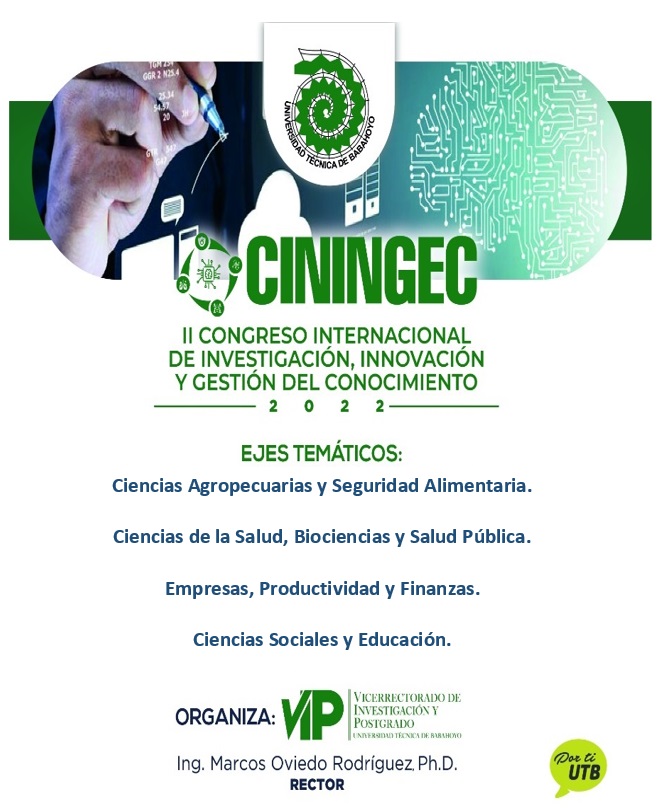EVALUANDO LA MEJORA EN EL DESEMPEÑO DE ESTUDIANTES DE INGLÉS COMO LENGUA EXTRANJERA UTILIZANDO ACTIVIDADES DE GRAMÁTICA Y VOCABULARIO EN NEARPOD
Palabras clave:
vocabulario; gramática, inglés, Nearpod.Resumen
La adquisición de vocabulario en el aprendizaje del idioma inglés, es tan importante para su correcto uso como la práctica gramatical. El presente estudio se enfoca en el uso de la plataforma Nearpod para mejorar las habilidades gramaticales y de vocabulario en los alumnos, referente a un curso de 14 semanas de duración y de nivel A2. Se escogieron cuatro paralelos, con una muestra de 30 estudiantes por curso de la Universidad Técnica de Babahoyo para la elaboración del presente documento, estos cursos fueron divididos en dos grupos: control y experimento. Se realizó un cuestionario pre-test al inicio del curso y un cuestionario post-test al término del mismo. Los resultados arrojan que existe diferencia significativa entre las medias de ambos grupos, tanto en vocabulario como en gramática, al obtener el grupo experimento una puntuación promedio de 14.80 y 15.80, respectivamente, mientras que para el grupo de control el promedio fue de 12.97 y 10.63, también respectivamente. Se concluye que Nearpod es una herramienta de total soporte para el proceso de aprendizaje y la mejora del aprovechamiento en los estudiantes, y de fácil acceso y claridad para los docentes. Finalmente, recomendamos altamente su uso, así buscamos incentivar una mayor investigación en esta área tan importante.
Descargas
Citas
Alobaid, A. (2021). ICT multimedia learning affordances: role and impact on ESL learners’ writing accuracy development. Heliyon, 7(7), e07517. https://doi.org/10.1016/J.HELIYON.2021.E07517
Barley, N., & Mikhailova, I. (2020). REAL-TIME FORMATIVE ASSESSMENT IN ONLINE LANGUAGE CLASSROOM. ICERI2020 Proceedings, 4671–4678.
Boers, F. (2021). Evaluating second language vocabulary and grammar instruction: A synthesis of the research on teaching words, phrases, and patterns. Routledge.
Brinchmann, E. I., Braeken, J., & Lyster, S. H. (2019). Is there a direct relation between the development of vocabulary and grammar? Developmental Science, 22(1), e12709.
Costuchen, A. L. (2020). Gamified Curriculum and Open-Structured Syllabus in Second-Language Teaching. In Challenges and Opportunities in Global Approaches to Education (pp. 35–55). IGI Global.
Faitaki, F., Hessel, A., & Murphy, V. A. (2020). Vocabulary and Grammar Development in Young Learners of English as an Additional Language. Handbook of Early Language Education, 1–21.
Holder, A., & Mills, B. (2020). Technologies Used by Student Teachers During a Virtual Time. Innovate Learning Summit, 702–706.
Lee, S. H. (2008). Beyond reading and proficiency assessment: The rational cloze procedure as stimulus for integrated reading, writing, and vocabulary instruction and teacher–student interaction in ESL. System, 36(4), 642–660. https://doi.org/10.1016/J.SYSTEM.2008.04.002
Mirzaev, A. B. U. (2022a). IMPROVING EFL/ESL CLASSROOMS THROUGH USING ONLINE PLATFORMS: NEARPOD–AS AN EXAMPLE OF TOP-RATED ONLINE EDUCATIONAL PLATFORMS. Central Asian Academic Journal of Scientific Research, 2(4), 264–270.
Mirzaev, A. B. U. (2022b). IMPROVING EFL/ESL CLASSROOMS THROUGH USING ONLINE PLATFORMS: NEARPOD–AS AN EXAMPLE OF TOP-RATED ONLINE EDUCATIONAL PLATFORMS. Central Asian Academic Journal of Scientific Research, 2(4), 264–270.
Naik, A. S., Kathavate, P. N., & Metagar, S. M. (2022). Nearpod: An Effective Interactive ICT Tool for Teaching and Learning Through Google Meet. In IOT with Smart Systems (pp. 269–276). Springer.
Pear Deck. (n.d.). Redefine how your students learn vocabulary. https://www.peardeck.com/pear-deck-vocabulary
Pupah, E. M., & Sholihah, U. (2022). Enhancing EFL students’ reading learning process in COVID-19 pandemic through Nearpod. Englisia: Journal of Language, Education, and Humanities, 9(2), 17–31.
Røkenes, F. M., & Krumsvik, R. J. (2016). Prepared to teach ESL with ICT? A study of digital competence in Norwegian teacher education. Computers & Education, 97, 1–20. https://doi.org/10.1016/J.COMPEDU.2016.02.014
Saunders, P. (2012). Functional grammar in the ESL classroom: Noticing, exploring and practising | Functional grammar in the ESL classroom: Noticing, exploring and practising, Rodney H. Jones, Graham Lock, Palgrave Macmillan, Houndmills, Basinstoke, UK (2011), vii + 146 pp. System, 40(2), 326–328. https://doi.org/10.1016/J.SYSTEM.2012.04.008
Selena, T. C., & Sanda, W. N. (2017). Exploring the use of Nearpod in the junior secondary reading classrooms. Exploring the Use of Nearpod in the Junior Secondary Reading Classrooms……………… 5, 5.
Srisakonwat, P. (2022). The effects of Nearpod application on improving vocabulary Knowledge of Mathayom Suksa 3 students at Sansaiwithayakom school in Chiang Mai province. วารสาร พุทธ ศาสตร์ ศึกษา, 13(1).
Walker, N., Monaghan, P., Schoetensack, C., & Rebuschat, P. (2020). Distinctions in the acquisition of vocabulary and grammar: An individual differences approach. Language Learning, 70(S2), 221–254.
Wu, Q. (2014). Learning ESL Vocabulary with Smartphones. Procedia - Social and Behavioral Sciences, 143, 302–307. https://doi.org/10.1016/J.SBSPRO.2014.07.409
Yang, Y., Li, Y., Wang, X., Liu, N., Jiang, K., Zhang, S., & Qiu, J. (2021). Cognitive inhibition mediates the relationship between ESL listening proficiency and English spoken word segmentation in Chinese learners: A functional near-infrared spectroscopy (fNIRS) study. Journal of Neurolinguistics, 59, 100987. https://doi.org/10.1016/J.JNEUROLING.2021.100987
Descargas
Publicado
Cómo citar
Número
Sección
Licencia
Derechos de autor 2022 Journal of Science and Research

Esta obra está bajo una licencia internacional Creative Commons Atribución-NoComercial-SinDerivadas 4.0.
Los autores mantienen los derechos sobre los artículos y por tanto son libres de compartir, copiar, distribuir, ejecutar y comunicar públicamente la obra bajo las condiciones siguientes:
Reconocer los créditos de la obra de la manera especificada por el autor o el licenciante (pero no de una manera que sugiera que tiene su apoyo o que apoyan el uso que hace de su obra).
No utilizar esta obra para fines comerciales.
Declaración de privacidad
Los nombres y direcciones de correo-e introducidos en esta revista se usarán exclusivamente para los fines declarados por esta revista y no estarán disponibles para ningún otro propósito u otra persona.

